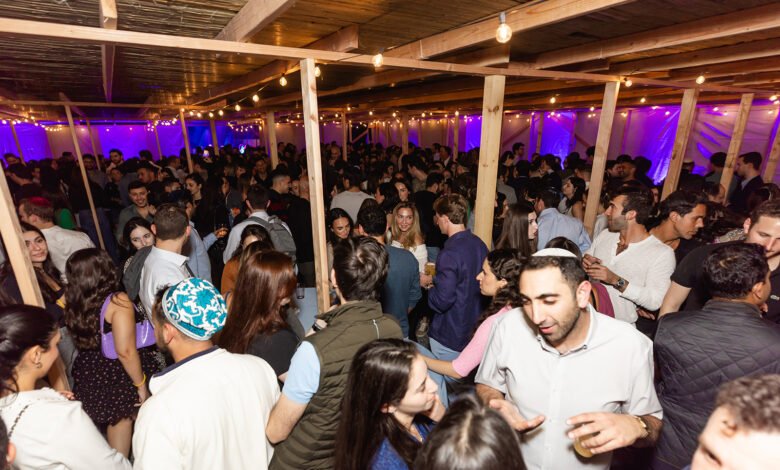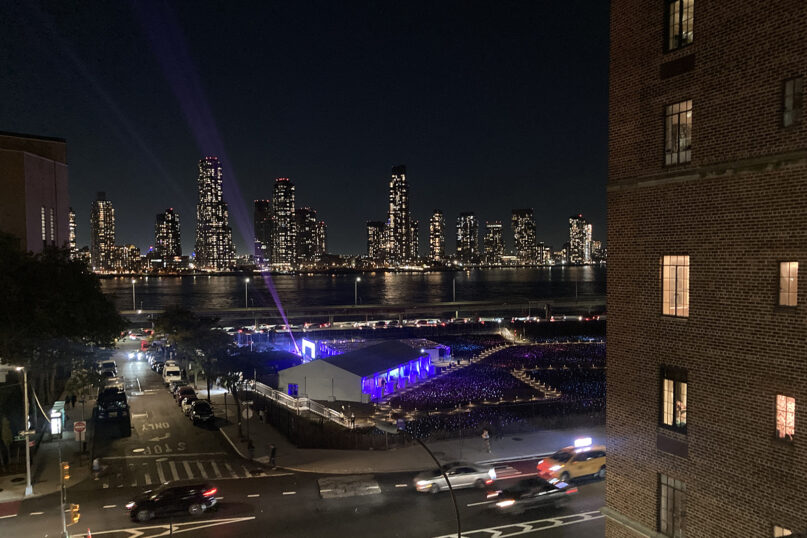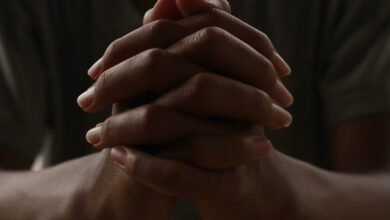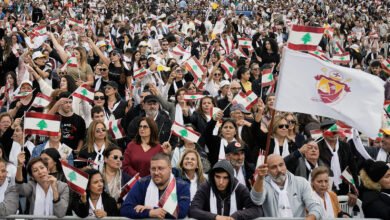Chabad Jews celebrate at 5,000-square-foot sukkah in New York

NEW YORK (RNS) — Sukkot is typically a quiet Jewish holiday, celebrated by hoisting a temporary structure called a sukkah outside the home and gathering inside it to eat meals and socialize.
There is nothing quiet, though, about the Chabad way of celebrating the Jewish holidays.
This year the Hasidic Jewish movement headquartered in Crown Heights, Brooklyn, put up what it says is Manhattan’s largest sukkah — a 5,000-square-foot wooden frame with walls made of sheets of bamboo in an East Side plaza.
To add further dazzle, the sukkah was placed next to an immersive art installation called “Field of Light,” a sea of 18,750 low-light, fiber-optic stemmed spheres in jewel tones installed between 37th and 41st streets.
Thousands of young Chabad men and women gathered at the sukkah at Freedom Plaza on Monday night (Oct. 21) under clear, starry skies.
Sukkot, known as the Festival of Tabernacles or Booths, begins five days after Yom Kippur. Jews celebrate by dwelling in sukkahs to commemorate the huts the Israelites may have used as they wandered through the desert after escaping slavery in Egypt, according to the biblical Exodus story.

People attend a Sukkot celebration on Manhattan’s East Side, Monday, Oct. 21, 2024. (Photo © Samii Stoloff Photography)
“It’s really special,” said Rabbi Avi Winner, a media relations director for Chabad. “It’s called the festival of joy. Each of us has the ability to illuminate, especially when it’s dark. That’s when we see everyone’s impact, and then there’s the collective impact.”
Chabad is known for its public, and often flashy, Jewish celebrations. Ahead of the holiday of Hanukkah, the Orthodox sect often erects 36-foot-tall menorahs outside the Plaza Hotel overlooking New York City’s Central Park. In cities with large Jewish populations, Chabad often features parades and car convoys during Hanukkah.
Libby Amber Shayo, a TikTok influencer with a Jewish dating podcast, attended the event and said it was especially meaningful this year in light of the events of last Oct. 7 in Israel, when 1,200 people were killed and 250 taken hostage by Hamas.
“We want to bring the community together, and now more than ever, we want to tell everyone to release the hostages and show our Jewish pride,” she said.
RELATED: Marking the horror of Oct. 7 amid Simchat Torah’s mandate to be joyful
But not all sukkah celebrations were as peaceful and light-filled.
Jewish university students on as many as 30 campuses tried to erect Gaza solidarity sukkahs. Most were torn down by administrators and police. At UCLA Monday night, one person was arrested on suspicion of failing to disperse after the university’s police department ordered around 40 protesters to leave Dickson Court North, where they had established a sukkah. It was later dismantled by police.

The “Field of Light” art installation next to a sukkah event on Manhattan’s East Side, Monday, Oct. 21, 2024. (RNS photo/Genevieve Charles)
At Brown University in Providence, Rhode Island, and at Northwestern University in Evanston, Illinois, “Gaza solidarity sukkahs” were intended to draw a connection between the biblical story of the Israelites fleeing Egypt and the mass displacement of civilians in the ongoing wars in Gaza and Lebanon.
The Northwestern University sukkah was torn down by campus police last week.
The Columbia University chapter of Jewish Voice for Peace and Columbia University Apartheid Divest built “liberation sukkahs.”
Last spring, Palestinian solidarity encampments sprang up across dozens of university campuses characterized by fiery speeches and slogans that drew accusations of antisemitism. This fall many campuses vastly restricted protests with new regulations.
The East Side sukkah event, which did not attempt to criticize Israel, was hosted by the Chabad Young Professionals from the Upper East Side, Upper West Side and Chelsea, and featured music and food.
David Behar, founder of the Miami Sephardic Club who attended the Chabad event, said: “This is my third year in a row doing this event, one of my personal favorites in New York. It’s always like the biggest turnout for any event that I know.”
RELATED: Amid Jewish vulnerability, Sukkot offers a lesson in dependence

The Chabad Young Professionals sukkah event on Manhattan’s East Side, Monday, Oct. 21, 2024. (RNS photo/Genevieve Charles)
Source link



